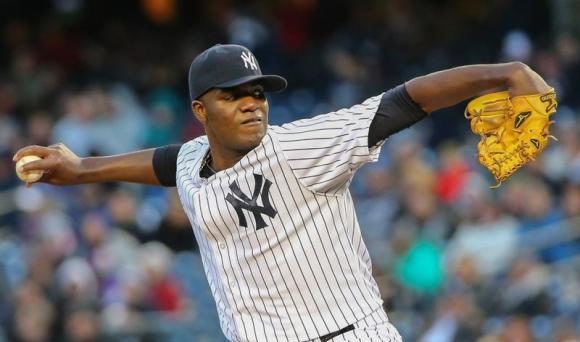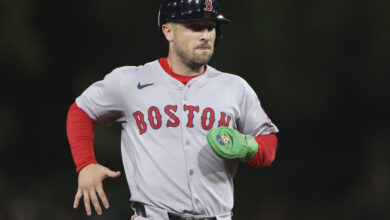
Three Intriguing Buy-Low Rotation Options for Cubs
Pitching is a priority for the Cubs this winter, particularly when it comes to their depleted rotation. Evan Altman has already covered some possible upper- and mid-level free agent options, but I would like to talk about some of the low-level or reclamation projects out there.
This front office has shopped in the bargain bin before, whether via trades or signings, with mixed results. Jake Arrieta, Jason Hammel, and Scott Feldman paid off nicely for Theo Epstein and crew. Brett Anderson, Chris Volstad, and Felix Doubront….not so much. The upside of a low-risk signing is that it’s easy to get rid of them if they don’t work out.
With that in mind, I’m going to focus on three potential discount options for 2018: Jeremy Hellickson, Tyler Chatwood, and Michael Pineda. Each of these pitchers has notable flaws offset by enticing upsides that make them perfect reclamation projects.
Hellickson spent the first five seasons of his career in Tampa under Joe Maddon and had a pair of excellent season in 2011 and ’12. He posted a 2.95 ERA in 189 innings in the former campaign, although a 4.44 FIP indicates Tampa’s defensive shifts probably helped him.
Three rough seasons followed before he landed on the rebuilding Phillies in 2016, pitching to a 3.71 ERA (3.98 FIP) and a career-high 20 percent strikeout rate. Hellickson’s numbers regressed in 2017, especially after a mid-season trade to Baltimore, so he’s not entering free agency on a high note.
Though the righty has a relatively low career strikeout rate of 17.4 percent, his 7.2 walk rate tells us that he’s not putting too many men on for free. One big knock on Hellickson is that hitters get big knocks on him; the 30-year-old (31 in April) has a combined fly/line drive rate north of 60 percent, which led to a home run spike (1.92 HR/9) in 2017.
It’d be a risk, but a return to his 2016 form would mean a solid bottom-of-the-rotation arm.
After posting a 3.72 ERA (3.44 FIP) in 28 starts in 2011 as a rookie for the Mariners, Pineda was sent to the Yankees in a trade for ice cream sandwich enthusiast Jesus Montero. A shoulder injury sidelined him for all of 2012 and kept him from reaching the majors again until 2014. Three uneven years followed, but Pineda’s stuff was nasty even if the results weren’t. A career strikeout rate of 24.4 percent, including 27.4 percent in 2016, combines with a career walk rate of 5.6 percent for an excellent 4.38 K/BB ratio.
Like a lot of pitchers at the new Yankee Stadium, Pineda has given up a ton of homers, 68 in the last three seasons, to be exact. The effect of the homers was obvious in FIP marks that were a full run lower than his ERA in both 2015 and ’16. The other obvious issue is health, as his 2017 season ended in July with Tommy John surgery that will keep him out until late 2018.
Still, his hard fastball and wipeout slider are tantalizing pitches and escaping that bandbox in the Bronx could make the 28-year-old (29 in January) Dominican an intriguing reclamation candidate.
Like Pineda, Chatwood debuted in 2011 and was traded the following season, after which injuries derailed his progress. Acquired by the Rockies from the Angels for Chris Ianetta in 2012, Chatwood only played parts of the three seasons following his rookie campaign.
He missed nearly all of 2015 (4.0 IP at A-ball) recovering from Tommy John surgery before having a breakout season in 2016. The righty made 27 starts, logging a 3.87 ERA (4.32 FIP) and an impressive 57.2 percent groundball rate. While that number actually jumped to over 58 percent this past season, home run/fly ball rate rate skyrocketed from 12.4 to 22 percent.
He struggled with control as well, walking a not-nice 4.69 batters per nine innings. The overall drop-off in Chatwood’s numbers saw him pitching out of the pen throughout much of the second half.
A career walk rate north of 10 percent is a cause of concern, as is a history of elbow issues. But Chatwood’s homer totals were no doubt inflated by the thin air of Coors Field, so moving to almost any other home ballpark will surely help that. And a groundball rate that has been near 60 percent over the past two seasons is a valuable asset for any pitcher in an era of juiced balls, increased exit velocity, and launch angles.
Add in that his average fastball velo of 94.7 mph in 2017 was easily the highest of his career and you can see why the young (28 in December) pitcher has a lot of appeal for teams with rotation slots to fill.
Any of these three arms could be an effective buy-low option for the Cubs, or they could be the next Brett Anderson. You never know which flea market painting has a copy of the Declaration of Independence on the back, so don’t be surprised to see one these guys calling Wrigley home next season.

